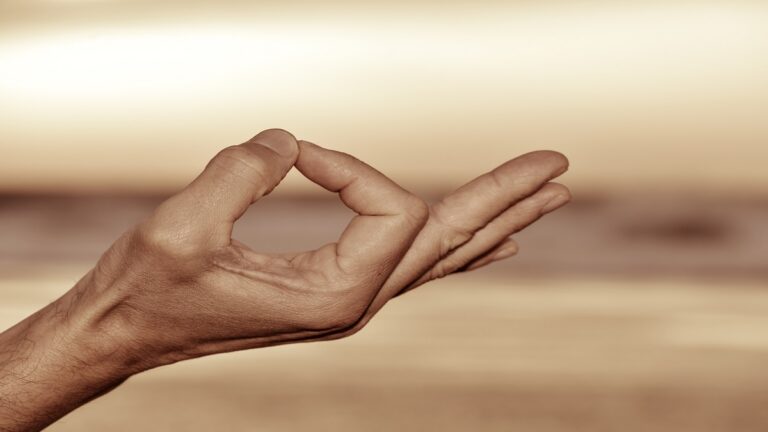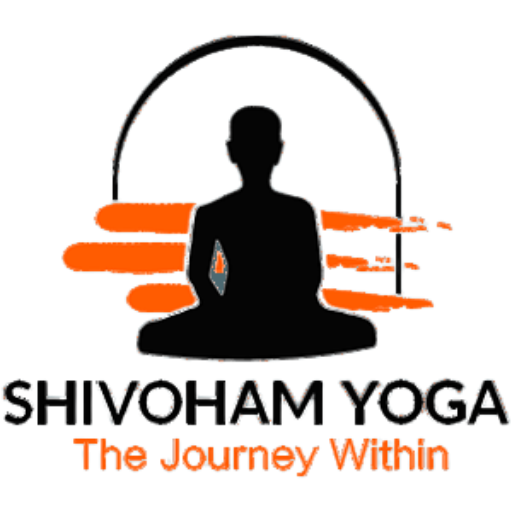Yoga Mudra
What is Yoga Mudra and Types
The Sanskrit word mudra is translated as ‘gesture’ or ‘attitude’. Mudras can be described as psychic, emotional, devotional and aesthetic gestures or attitudes. Yogis have experienced mudras as attitudes of energy flow, intended to link individual pranic force with universal or cosmic force.
The Kularnava Tantra traces the word mudra to the root mud, meaning ‘delight’ or ‘pleasure’, and dravay, the causal form of dnt, which means ‘to draw forth’. Mudra is also defined as a ‘seal’, ‘short-cut’ or ‘circuit by-pass’. Mudras are a combination of subtle physical movements which alter mood, attitude and perception, and which deepen awareness and concentration.
A mudra may involve the whole body in a combination of asana, pranayama, bandha and visualization techniques, or it may be a simple hand position. The Hatha Yoga Pradipika and other yogic texts consider mudra to be a yoganga, an independent branch of yoga, requiring a very subtle awareness.
Mudras are introduced after some proficiency has been attained in asana, pranayama and bandha, and gross blockages have been removed. Mudras have been described in various texts from antiquity to the present day in order to preserve them for posterity. However, such references were never detailed or clearly delineated as these techniques were not intended to be learned from a book.
Practical instruction from a guru was always considered to be a necessary requisite before attempting them. Mudras are higher practices which lead to awakening of the pranas, chakras and kundalini, and which can bestow major siddhis, psychic powers, on the advanced yoga practitioner

Mudras and prana The attitudes and postures adopted during mudra practices establish a direct link between annamaya kosha, the physical body, manomaya kosha, the mental body and pranamaya kosha, the energy body. Initially, this enables the practitioner to develop awareness of the flow ofprana in the body. Ultimately, it establishes pranic balance within the koshas and enables the redirection of subtle energy to the upper chakras, inducing higher states of consciousness.
Mudras manipulate prana in much the same way that energy in the form of light or sound waves is diverted by a mirror or a cliff face. The nadis and chakras constantly radiate prana which normally escapes from the body and dissipates into the external world. By creating barriers within the body through the practice of mudra, the energy is redirected within. For example, by closing the eyes with the fingers in shanmukhi mudra, the prana being radiated through the eyes is reflected back. In the same way, the sexual energy emitted through vajra nadi is redirected to the brain through the practice of vajroli mudra.
Tantric literature states that once the dissipation of prana is arrested through the practice of mudra, the mind becomes introverted, inducing states of pratyahara, sense withdrawal, and dharana, concentration. Because of their ability to redirect prana, mudras are important techniques for awakening kundalini. For this reason they are incorporated extensively in kriya and kundalini yoga practices.
A scientific look at mudras In scientific terms, mudras provide a means to access and influence the unconscious reflexes and primal, instinctive habit patterns that originate in the primitive areas of the brain around the brain stem. They establish a subtle, non-intellectual connection with these areas. Each mudra sets up a different link and has a correspondingly different effect on the body, mind and prana. The aim is to create fixed, repetitive postures and gestures which can snap the practitioner out of instinctive habit patterns and establish a more refined consciousness.
What are FIVE GROUPS OF YOGA MUDRAS
The yoga mudras can be categorized into approximately five groups , which are described as follows.
What is Hasta (hand mudras)?
The hand mudras presented in this book are meditative mudras. They redirect the prana emitted by the hands back into the body. Mudras which join the thumb and index finger engage the motor cortex at a very subtle level. They generate a loop of energy which moves from the brain down to the hand and then back again. Conscious awareness of this process rapidly leads to internalization. Techniques included in this category are:
- Jnana mudra
- Chin mudra
- Yoni mudra
- Bhairava mudra
- Hridaya mudra.
What is Mana (head mudras)?
These practices form an integral part of kundalini yoga and many are meditation techniques in their own right. They utilize the eyes, ears, nose, tongue and lips. Techniques included in this category are:
- Shambhavi mudra
- Nasikagra drishti
- Khechari mudra
- Kaki mudra
- Bhujangini mudra
- Bhoochari mudra
- Akashi mudra
- Shanmukhi mudra
- Unmani mudra.
What is KAYA (POSTURAL MUDRAS)
There practices utilize physical postures combined with breathing and concentration, techniques included in these category are:
- Vipareeta karani mudra
- Pashinee mudra
- Prana mudra
- Yoga mudra
- Manduki mudra
- Tadagi mudra.
What are Bandhas (lock mudras)?
These practices combine mudra and bandha. They charge the system with prana and prepare it for kundalini awakening. Techniques included in this category are:
Maha mudra
Maha bheda mudra
What is Adhara (perineal mudras)?
These techniques redirect prana from the lower centres to the brain. Mudras concerned with sublimating sexual energy are in this group. Techniques included in this category are:
- Ashwini mudra
- Vajroli/sahajoli mudra.
Between them these five groups engage substantial areas of the cerebral cortex. The comparatively large number of head and hand mudras reflects the fact that the operation and interpretation of information coming in from these two areas occupies approximately fifty percent of the cortex. Mudras are performed either in combination with or after asana and pranayama. The mudras presented in this book represent a small selection of those discussed in the yogic texts.
wHAT IS Jnana Mudra (psychic gesture of knowledge)?
Assume a comfortable meditation posture. Fold the index fingers so that they touch the inside root of the thumbs. Straighten the other three fingers of each hand so that they are relaxed and slightly apart. Place the hands on the knees with the palms facing down. Relax the hands and arms.
wHAT IS Chin Mudra (psychic gesture of consciousness) ?
Chin mudra is performed in the same way as jnana mudra, except that the palms of both hands face upwards, with the backs of the hands resting on the knees. Relax the hands and arms. Sequence: One of these two mudras should be adopted whenever practising meditation, unless otherwise specified. Benefits: J nana mudra and chin mudra are simple but important psycho-neural finger locks which make meditation asanas more powerful. The palms and fingers of the hands have many nerve root endings which constantly emit energy. When the index finger touches the thumb, a circuit is produced which allows the energy that would normally dissipate into the environment to travel back through the body and up to the brain. When the fingers and hands are placed on the knees, the knees are sensitized, creating another pranic circuit that maintains and redirects prana within the body. In addition, placing the hands on the knees stimulates a nadi which runs from the knees, up the inside of the thighs and into the perineum. This nadi is known as gupta or the hidden nadi. Sensitizing this channel helps to stimulate the energies at mooladhara chakra. When the palms face upward in chin mudra, the chest area is opened up. The practitioner may experience this as a sense of lightness and receptivity, which is absent in the practice of jnana mudra.
What is Yoni Mudra (attitude of the womb or source) ?
Assume a comfortable meditation posture with the head and spine straight. Place the palms of the hands together with the fingers and thumbs straight and pointing away from the body. Keeping the pads of the index fingers together, turn the little, ring and middle fingers inwards so that the backs of the fingers are touching. Interlock the little, ring and middle fingers. Bring the thumbs towards the body and join the pads of the fingers together to form the base of a yoni or womb shape.
wHAT IS Benefits OF MUDRA?
The interlocking of the fingers in this practice creates a complete cross-connection of energies from the right hand into the left and vice versa. As well as balancing the energies in the body, it helps to balance the activities of the right and left hemispheres of the brain.
Placing the tips of the index fingers and thumbs together further intensifies the flow of prana. This mudra makes the body and mind more stable in meditation and develops greater concentration, awareness and internal physical relaxation.
It redirects prana back into the body which would otherwise be dispersed through the hands and fingers. The elbows naturally tend to point to the side when performing this mudra which helps open up the chest area.
wHAT IS Hridaya Mudra (heart gesture) –
Sit in any comfortable meditation asana with the head and spine straight. Place the tips of the index fingers at the root of the thumbs, as in chin and jnana mudras, and join the tips of the middle and ring fingers to the tips of the thumbs. The little finger remains straight. Place the hands on the knees with the palms facing upward. Close the eyes and relax the whole body, keeping it motionless. Duration: This practice may be performed for up to 30 minutes. Awareness: Physical- on the breath in the chest area. Spiritual-on anahata chakra. Benefits: This mudra diverts the flow of prana from the hands to the heart area, improving the vitality of the heart. The middle and ring fingers relate directly to nadis connected with the heart, while the thumb closes the pranic circuit and acts as an energizer, diverting the flow of prana from the hands to these nadis . Hridaya mudra is therefore beneficial for the heart. It is very simple and may be used safely and easily, even in acute situations. The heart is the centre of emotion. Hridaya mudra helps to release pentup emotion and unburden the heart. It may be practised during emotional conflict and crisis.
Thanks for Reading This, Please Check Our Upcoming Yoga Teacher Training courses.
More Yoga Links:
✔ 200 hour yoga teacher training in goa,India
✔ 200 hour yoga teacher training in Rishikesh,India
✔ 100 hour yoga teacher training in Rishikesh,India
✔ 100 hour yoga teacher training in goa,India
✔ 100 hour yoga teacher training in goa,India
✔ Ashtanga teacher training in goa,India
✔ Vinyasa yoga teacher training in goa,India
✔ 100 hour yoga teacher training in Rishikesh,India
✔ yoga teacher training in Goa,India

